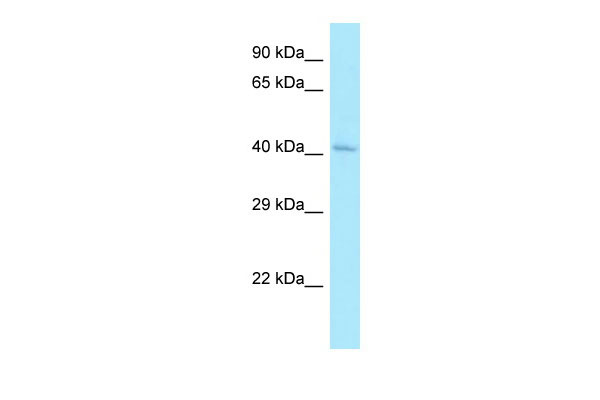CLP1 antibody - N-terminal region
Rabbit Polyclonal Antibody
- SPECIFICATION
- CITATIONS
- PROTOCOLS
- BACKGROUND

Application
| WB |
|---|---|
| Primary Accession | Q92989 |
| Other Accession | NM_001142597, NP_001136069 |
| Reactivity | Human, Mouse, Rat, Rabbit, Pig, Horse, Bovine, Guinea Pig, Dog |
| Predicted | Human, Mouse, Rat, Rabbit, Pig, Horse, Bovine, Guinea Pig, Dog |
| Host | Rabbit |
| Clonality | Polyclonal |
| Calculated MW | 41kDa |
| Gene ID | 10978 |
|---|---|
| Alias Symbol | HEAB, hClp1 |
| Other Names | Polyribonucleotide 5'-hydroxyl-kinase Clp1 {ECO:0000255|HAMAP-Rule:MF_03035}, 2.7.1.78 {ECO:0000255|HAMAP-Rule:MF_03035}, Polyadenylation factor Clp1 {ECO:0000255|HAMAP-Rule:MF_03035}, Polynucleotide kinase Clp1 {ECO:0000255|HAMAP-Rule:MF_03035}, Pre-mRNA cleavage complex II protein Clp1 {ECO:0000255|HAMAP-Rule:MF_03035}, CLP1 {ECO:0000255|HAMAP-Rule:MF_03035}, HEAB |
| Format | Liquid. Purified antibody supplied in 1x PBS buffer with 0.09% (w/v) sodium azide and 2% sucrose. |
| Reconstitution & Storage | Add 50 ul of distilled water. Final anti-CLP1 antibody concentration is 1 mg/ml in PBS buffer with 2% sucrose. For longer periods of storage, store at 20°C. Avoid repeat freeze-thaw cycles. |
| Precautions | CLP1 antibody - N-terminal region is for research use only and not for use in diagnostic or therapeutic procedures. |
| Name | CLP1 {ECO:0000255|HAMAP-Rule:MF_03035} |
|---|---|
| Synonyms | HEAB |
| Function | Polynucleotide kinase that can phosphorylate the 5'-hydroxyl groups of double-stranded RNA (dsRNA), single-stranded RNA (ssRNA), double-stranded DNA (dsDNA) and double-stranded DNA:RNA hybrids. dsRNA is phosphorylated more efficiently than dsDNA, and the RNA component of a DNA:RNA hybrid is phosphorylated more efficiently than the DNA component. Plays a key role in both tRNA splicing and mRNA 3'-end formation. Component of the tRNA splicing endonuclease complex: phosphorylates the 5'-terminus of the tRNA 3'-exon during tRNA splicing; this phosphorylation event is a prerequisite for the subsequent ligation of the two exon halves and the production of a mature tRNA (PubMed:24766809, PubMed:24766810). Its role in tRNA splicing and maturation is required for cerebellar development (PubMed:24766809, PubMed:24766810). Component of the pre-mRNA cleavage complex II (CF-II), which seems to be required for mRNA 3'-end formation. Also phosphorylates the 5'-terminus of exogenously introduced short interfering RNAs (siRNAs), which is a necessary prerequisite for their incorporation into the RNA-induced silencing complex (RISC). However, endogenous siRNAs and microRNAs (miRNAs) that are produced by the cleavage of dsRNA precursors by DICER1 already contain a 5'-phosphate group, so this protein may be dispensible for normal RNA-mediated gene silencing. |
| Cellular Location | Nucleus {ECO:0000255|HAMAP-Rule:MF_03035, ECO:0000269|PubMed:11060040, ECO:0000269|PubMed:24766810} |

Thousands of laboratories across the world have published research that depended on the performance of antibodies from Abcepta to advance their research. Check out links to articles that cite our products in major peer-reviewed journals, organized by research category.
info@abcepta.com, and receive a free "I Love Antibodies" mug.
Provided below are standard protocols that you may find useful for product applications.
References
Tanabe S.,et al.Blood 88:3535-3545(1996).
Ota T.,et al.Nat. Genet. 36:40-45(2004).
Mural R.J.,et al.Submitted (JUL-2005) to the EMBL/GenBank/DDBJ databases.
de Vries H.,et al.EMBO J. 19:5895-5904(2000).
Paushkin S.V.,et al.Cell 117:311-321(2004).
If you have used an Abcepta product and would like to share how it has performed, please click on the "Submit Review" button and provide the requested information. Our staff will examine and post your review and contact you if needed.
If you have any additional inquiries please email technical services at tech@abcepta.com.













 Foundational characteristics of cancer include proliferation, angiogenesis, migration, evasion of apoptosis, and cellular immortality. Find key markers for these cellular processes and antibodies to detect them.
Foundational characteristics of cancer include proliferation, angiogenesis, migration, evasion of apoptosis, and cellular immortality. Find key markers for these cellular processes and antibodies to detect them. The SUMOplot™ Analysis Program predicts and scores sumoylation sites in your protein. SUMOylation is a post-translational modification involved in various cellular processes, such as nuclear-cytosolic transport, transcriptional regulation, apoptosis, protein stability, response to stress, and progression through the cell cycle.
The SUMOplot™ Analysis Program predicts and scores sumoylation sites in your protein. SUMOylation is a post-translational modification involved in various cellular processes, such as nuclear-cytosolic transport, transcriptional regulation, apoptosis, protein stability, response to stress, and progression through the cell cycle. The Autophagy Receptor Motif Plotter predicts and scores autophagy receptor binding sites in your protein. Identifying proteins connected to this pathway is critical to understanding the role of autophagy in physiological as well as pathological processes such as development, differentiation, neurodegenerative diseases, stress, infection, and cancer.
The Autophagy Receptor Motif Plotter predicts and scores autophagy receptor binding sites in your protein. Identifying proteins connected to this pathway is critical to understanding the role of autophagy in physiological as well as pathological processes such as development, differentiation, neurodegenerative diseases, stress, infection, and cancer.


